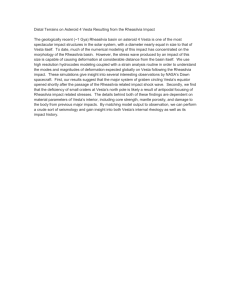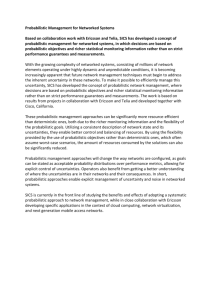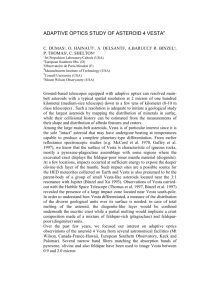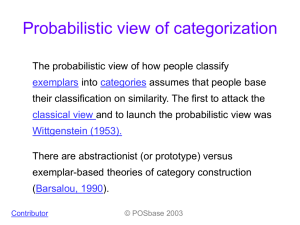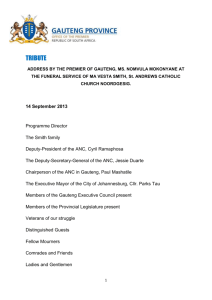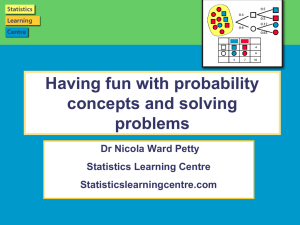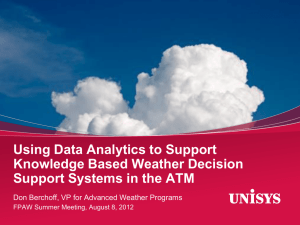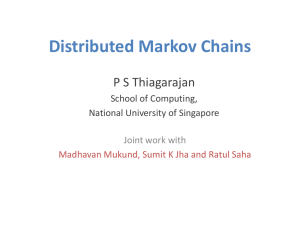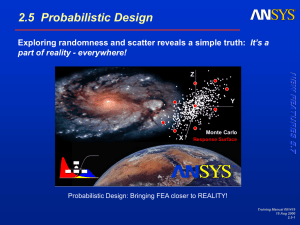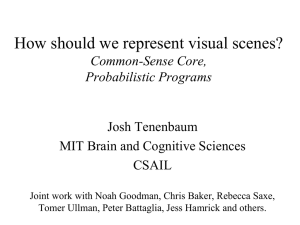slides - University of California, Berkeley
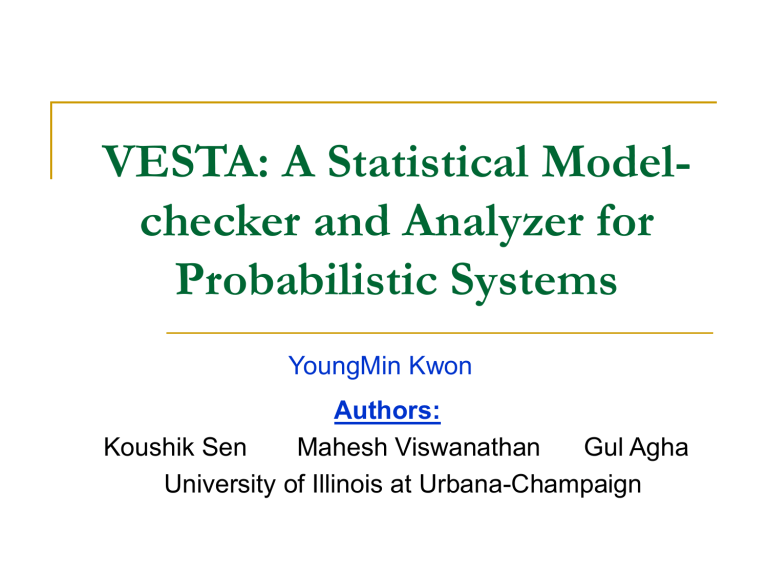
VESTA: A Statistical Modelchecker and Analyzer for
Probabilistic Systems
YoungMin Kwon
Authors:
Koushik Sen Mahesh Viswanathan Gul Agha
University of Illinois at Urbana-Champaign
Vesta Tool
Input: A probabilistic model M given as
a Java class on which one can perform discrete-event simulation a CTMC model in a special language (similar to that used in PRISM) a Probabilistic Rewrite Theory in Maude
Vesta Tool
Input: A probabilistic model M given as
a Java class on which one can perform discrete-event simulation a CTMC model in a special language (similar to that used in PRISM) a Probabilistic Rewrite Theory in Maude
Input: A formula F in Continuous Stochastic Logic
(CSL) or Probabilistic Computation Tree Logic
(PCTL)
Vesta can model check F against M, i.e. check if M
² F
Vesta Tool
Input: A probabilistic model M given as
a Java class on which one can perform discrete-event simulation a CTMC model in a special language (similar to that used in PRISM) a Probabilistic Rewrite Theory in Maude
Input: A formula F in Continuous Stochastic Logic
(CSL) or Probabilistic Computation Tree Logic
(PCTL)
Vesta can model check F against M, i.e. check if M
² F
Input: An expression E in Quantitative Temporal
Expressions (QuaTEx)
Vesta can compute the expected value of E
Model Assumption
Sample execution paths can be generated through discrete-event simulation
Execution paths are sequences of the form
= s
0 t
0
! s
1 t
1
! s
2
!
… t
2 where each s i is a state of the model and t i spent in the state s i
2 R
>0 before moving to the state s is the time i
+1
A probability space can be defined on the execution paths of the model in such a way that the paths satisfying any path formula in our concerned logic
(CSL or PCTL), is measurable
Continuous Stochastic Logic (CSL) and PCTL
::= true | a |
Æ
| :
| P
Q p
::=
U <t
|
U
| X
(
) where Q 2 {<,>, ¸ , · }
P
< 0.5
( § full)
Probability that queue becomes full is less than
0.5
P
>0.98
( : retransmit U receive)
Probability that a message is eventually received successfully without any need for retransmission is greater than 0.98
Model Checking: Main Result Summarized
Our algorithm A takes as input
a stochastic model M, a formula
in CSL, error bounds
and
, and three other parameters
1
,
2
, and p s
.
The result of model checking is denoted by
A
1
,
2
,ps (M,
,
,
)
can be either true or false.
Details in [Sen et al. CAV’05]
Model Checking: Main Result Summarized
Theorem: If the model M satisfies the following conditions
C1: For every subformula of the form P
¸ p
in the formula
and for every state s in M, the probability that a path from s satisfies
must not lie in the range
[ (p-
1
-
)/(1-
),(p+
1
)/(1-
)]
C2: For any subformula of the form
1
U
2 and for every state s in M, the probability that a path from s satisfies
1
U
2 must not lie in the range (0,
2
/((1-p s
) N-1 q N-1 )], where N is the number of states in the model M and q is the smallest non-zero transition probability in M
Then the algorithm provides the following guarantees
R1 :
Pr[A
1
,
2
,ps
Pr[A
1
,
2
,ps
(M,
,
,
) = true | M 2
] ·
(M,
,
,
) = false | M ²
] ·
Quantitative Queries Using QuaTEx
What is the expected number of clients that successfully connect to S?
CountConnected() = if completed() then count() else ° (CountConnected()) fi; eval E[ CountConnected() ]
Quantitative Queries Using QuaTEx
What is the probability that a client connected to S within 10 seconds after it initiated the connection request?
Prob() = if globaltime()>10 then 0.0 else if connected() then 1.0 else ° (Prob()) fi fi; eval E[ Prob() ]
Evaluation of QuaTEx
The expected value of a QuaTEx expression is statistically evaluated with respect to two parameters
and
provided as input.
We approximate the expected value by the mean of n samples such that the size of
(1−
)100% confidence interval for the expected value computed from the samples is bounded by
.
Details in [Agha et al. QAPL’05]
Vesta Screenshot
Conclusion
Vesta 2.0 supports
statistical model checking of probabilistic systems
query various quantitative aspects of a probabilistic system
The tool is available for download at http://osl.cs.uiuc.edu/~ksen/vesta2/
